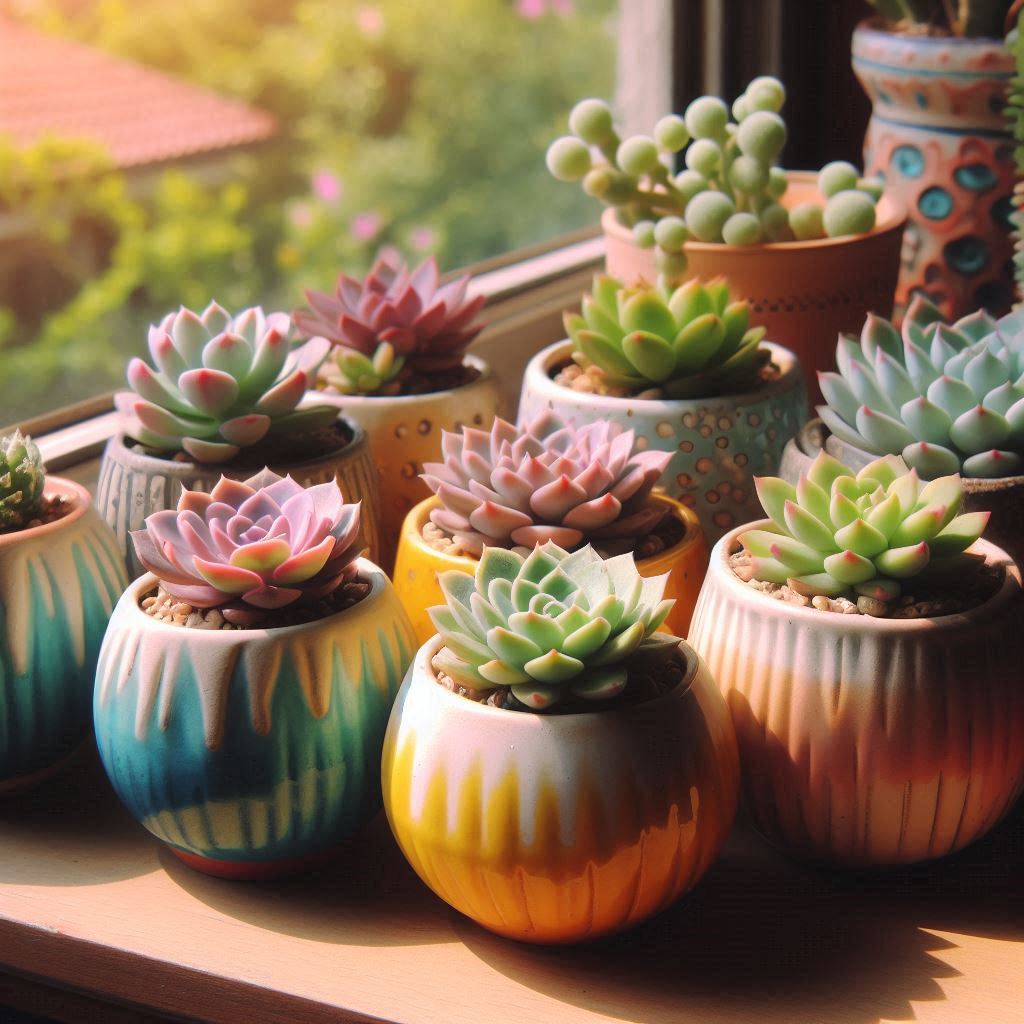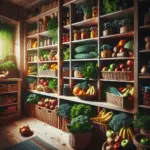Do succulents need drainage holes to survive? It’s a common question among plant enthusiasts. Understanding succulent watering needs and the role of drainage can significantly impact plant health. In this blog post, we delve into essential tips for maintaining your succulents.
Why Drainage Holes Are Important for Succulents
Succulents are popular for their striking appearance and easy care, but ensuring they thrive involves providing the right conditions. One crucial factor for their healthy growth is the presence of drainage holes in pots. These holes allow excess water to escape, preventing the roots from sitting in water, which can lead to root rot. Succulents, native to arid environments, are adapted to store water in their leaves and stems, meaning they are more prone to the harmful effects of overwatering.
Without drainage holes, the water becomes trapped within the pot, creating a soggy environment similar to a swamp rather than a desert. This moisture level is detrimental to succulents as it restricts airflow to the roots and causes the plant tissues to break down. When planting succulents, it’s important to consider the pot material as well. Porous materials like terracotta can help in wicking moisture away, while non-porous materials like plastic retain more water.
The Benefits of Drainage Holes in Succulent Care
Drainage holes contribute positively to the health of succulents by promoting a more natural flow of water. When watering succulents, any excess that isn’t absorbed by the soil immediately should flow out of the pot. This action simulates the plant’s natural habitat where rainwater drains quickly, leaving the soil dry. Properly drained soil helps in maintaining the correct moisture balance that succulents need to develop robust root systems and prevent diseases.
Moreover, using drainage holes can prevent the buildup of salts and minerals that accumulate from water and fertilizers. These can create a toxic environment for succulents if allowed to concentrate in the soil. Flushing out these substances protects the integrity of the plant, ensuring that it remains vibrant and healthy over time.
Can Succulents Survive in Pots Without Drainage Holes?
Succulents are renowned for their ability to store water in their leaves, enabling them to thrive in arid conditions. However, when grown in pots without drainage holes, the challenge is managing moisture levels to prevent root rot. Without adequate drainage, water can accumulate at the bottom of the pot, leading to soggy conditions that are detrimental to succulent health.
This raises the question: do succulents need drainage holes? While it is possible for succulents to adapt to containers lacking proper drainage, this requires careful attention to watering practices. One method is to use a well-draining soil mix composed of ingredients like perlite, coarse sand, and cactus soil, which can help mimic the arid environment succulents are accustomed to. This mixture allows water to pass through quickly, reducing the risk of waterlogging.
Additionally, watering should be infrequent; succulents in pots without drainage need water only when their soil is completely dry. Using a moisture meter can aid in determining the appropriate time to water. Placing a layer of rocks or pebbles at the base of the pot is a debated practice; while it can provide some space for water to pool away from roots, it is not a substitute for drainage holes.
Choosing the right succulent varieties can also aid survival. Some species are more tolerant to less-than-ideal drainage conditions, such as Gasteria and Haworthia, which naturally grow in rocky habitats with little soil.
In conclusion, while not ideal, growing succulents in pots without drainage holes is achievable with diligent care. Understanding the species-specific needs and consistently monitoring moisture levels are key to ensuring your succulents remain healthy and vibrant.
How Overwatering Affects Succulents in Pots Without Drainage
Succulents are well-known for their ability to thrive in environments with infrequent watering, but there is a common misconception that they can easily manage in pots without drainage. The reality is that overwatering is a significant issue for succulents, especially in containers that do not allow excess water to escape. Without proper drainage, succulents face the risk of root rot, which can lead to the demise of the plant.
Succulents require a delicate balance of water. When the roots sit in waterlogged soil, they cannot breathe and absorb the nutrients they need. In pots without drainage holes, soil remains damp for prolonged periods. This creates an environment conducive to the growth of bacteria and fungi, further threatening the health of succulents.
The absence of drainage limits the plant’s ability to regulate moisture levels effectively. Even with careful watering techniques, it’s nearly impossible to prevent water accumulation in the base of the pot. Monitoring the moisture level becomes crucial, as does the choice of soil. Opting for a gritty, fast-draining soil mix can mitigate some risks, but it cannot fully replace the need for drainage holes.
It’s essential to adjust your watering routine to account for the lack of drainage. Water sparingly and avoid adding more until the soil has dried out completely. Consider using a moisture meter to ensure the plant isn’t sitting in overly damp conditions.
The Role of Drainage in Preventing Root Rot in Succulents
Succulents are renowned for their ability to store water in arid environments, but one of the most crucial aspects of their care is understanding how drainage plays into preventing root rot. Without proper drainage, water can accumulate at the bottom of the pot, suffocating the roots and leading to rot.
Drainage holes are vital as they allow excess water to escape, keeping the soil dry and the roots healthy. If you’re using a pot without drainage holes, extra attention must be paid to watering practices. Overwatering is one of the most common issues when growing succulents. Even initially healthy succulents can decline quickly if left sitting in waterlogged soil.
This raises the question: do succulents need drainage holes? To mitigate potential root rot, consider layering the bottom of your pot with rocks, pebbles, or broken pottery pieces to improve drainage. However, this is not a foolproof solution, as water may still accumulate over time. Be sure to use a fast-draining soil mix specifically designed for succulents; these mixes are often a combination of potting soil, sand, and perlite or pumice, which helps ensure that water does not linger around the roots.
Monitoring soil moisture levels is also key. Insert your finger about an inch into the soil or use a moisture meter to assess whether watering is necessary. Remember, succulents prefer their soil to dry out between waterings, especially when they are in containers without adequate drainage.
Understanding these principles can support healthy succulent growth and drastically reduce the chances of root rot. Maintaining a vigilant eye on your watering habits and soil conditions will keep your succulents thriving, even in less-than-ideal potting arrangements.
How to Care for Succulents in Containers Without Drainage
To successfully care for succulents in containers lacking drainage, it’s crucial to understand their unique watering needs. Succulents naturally store water in their leaves, stems, or roots, making them more drought-resistant. Without drainage holes, the challenge is to prevent excess water that can lead to root rot.
First, use a well-draining soil mix designed for cacti and succulents. This type of soil helps facilitate aeration and moisture retention. Incorporating materials like perlite, pumice, or coarse sand can significantly improve the soil’s drainage.
Watering requires a careful approach. Use a minimal amount, ensuring the soil is moist but not soaked. Monitor your plant closely; wait for the soil to dry out completely before watering again. This mimics their natural dry environment and reduces the risk of overwatering.
This raises the question: do succulents need drainage holes? Consider adding a layer of rocks or pebbles at the bottom of the container. While this won’t replace drainage holes, it can help improve drainage by creating space for excess water if needed.
Placing your succulent in a location where it can receive plenty of indirect sunlight is also beneficial. Good light exposure encourages healthy growth and helps the soil dry out faster.
Keeping an eye on the plant’s condition will guide you in adjusting your care approach. If you notice signs of overwatering, such as mushy leaves, take immediate action by reducing water intake and ensuring more sunlight exposure.
DIY Solutions: Adding Drainage to Succulent Pots
Adding drainage to your succulent pots can be an easy and rewarding DIY solution. When succulents are planted in pots without drainage holes, the risk of overwatering and root rot increases. Therefore, creating a way for water to escape is essential. One effective method is to drill holes at the bottom of pots using a ceramic or masonry drill bit, especially for ceramic containers.
Alternative Drainage Techniques
If drilling holes isn’t an option, consider layering the bottom of your pot with coarse material such as pebbles, pumice, or activated charcoal. This will help excess water move away from the roots. Another strategy involves double potting—placing the succulent in a smaller pot with drainage and situating it inside a decorative pot.
Maximizing Absorption
Utilizing a well-draining soil mix designed for succulents is crucial. Adding coarse sand or perlite can improve soil aeration and drainage. Regularly check moisture levels; the top rim should dry out between waterings.
These diy solutions not only protect your succulents but also enable you to enjoy them in any pot you choose. It ensures that water finds a way out, keeping your plants hearty and vibrant.
What Happens If Succulents Are Grown Without Proper Drainage?
Succulents need proper drainage to thrive. Without it, they can suffer from waterlogged roots, leading to root rot and ultimately plant death. When succulents are grown without proper drainage, the excess water accumulates in the soil instead of escaping through drainage holes. This creates a habitat suitable for fungi and bacteria, which attack the roots.
The lack of drainage leads to overly moist soil, a common threat to plants like succulents, which naturally grow in arid environments. These plants are adapted to survive with minimal water, storing it in their leaves and stems. Without the ability to release excess moisture, succulents become prone to root rot—a condition where the roots decay due to constant exposure to water.
Another significant impact of inadequate drainage is pest attraction. Wet conditions invite pests like gnats, which tend to infest overwatered plants. Consequently, dealing with pest infestations can become an additional problem for your succulents.
Even when growing in pots without drainage, it’s crucial to adjust care techniques to prevent these issues. Opt for well-draining soil to mimic natural conditions and avoid overwatering, letting the soil dry between watering sessions. Techniques like bottom watering can also help manage moisture levels effectively.
Using containers with drainage holes is ideal for succulents, but if unavailable, maintaining proper moisture levels becomes critical. Incorporating materials like pumice or perlite into your potting mix can improve aeration and help mimic the needed drainage in non-draining pots. Additionally, closely monitoring watering frequency and understanding the moisture needs of different succulent varieties are vital steps in ensuring their health despite suboptimal growing conditions.
How to Water Succulents in Pots Without Drainage Holes

Watering succulents in pots without drainage holes can be tricky, but with the right techniques, you can keep your plants healthy. Start by using a small amount of water to avoid oversaturating the soil. Ideally, choose a soil mixture designed for cacti and succulents, as it promotes better drainage and prevents overwatering.
Monitor Soil Moisture
Use your finger or a moisture meter to check the soil moisture level before watering. Succulents need less water than most other plants, so it’s crucial to let the soil dry out completely before the next watering session. This mimics their natural arid environment and helps prevent root rot.
Water Control Techniques
One effective method is to water using a squeeze bottle or a turkey baster. This allows for targeted, minimal watering directly at the root zone and avoids water collecting at the bottom of the pot. It’s a great way to control how much water you’re giving your plants.
Consider Using a Wick System
A wick system can help manage moisture levels in pots without drainage holes. Insert a wick made of cotton or nylon from the bottom of the pot to a saucer filled with water. As the soil dries, it will draw up water through the wick, ensuring consistent moisture without overwatering.
Remember, less is more when it comes to watering succulents in pots without drainage. Adjust your watering habits based on the local climate and humidity levels, as they will affect how quickly soil loses moisture.
Succulent Varieties That Tolerate Poor Drainage Conditions
Many succulents thrive in dry environments, but some varieties can tolerate poor drainage conditions. These resilient plants often have adaptations making them suitable for areas where water flow isn’t optimal. Aloe vera is one such example, known for its ability to store moisture in its thick leaves. It can manage periods of excess moisture without developing root rot quickly.
Another succulent that doesn’t mind poor drainage is the Zebra Plant (Haworthia). This plant has leaves with pointed tips and can adapt to a variety of soil types, including those with less-than-ideal drainage.
The Echeveria species, popular for its rosette shape, usually prefers well-drained soil but can handle occasional overwatering better than some other succulents. Its waxy leaves help protect against excess moisture.
While these varieties may endure poor drainage conditions, it’s crucial to monitor their watering needs. Since succulents are generally drought-tolerant, ensuring the right balance between moisture and dryness is key for their health in less suitable environments.
Consider using thicker leaves and strong root systems as indicators of succulents that may cope better in low-draining soils. This can guide your choice if adapting succulent care to different environments.
Improving Drainage in Succulent Planters: Tips and Tricks
When it comes to growing succulents, ensuring proper drainage is crucial. Without adequate drainage, water can accumulate in the planter, leading to root rot and other issues that can harm these resilient plants. This raises the important question: do succulents need drainage holes? The answer is a resounding yes, as proper drainage is essential for their health.
Improving drainage in succulent planters can be achieved with a few strategic methods. First, use a well-draining soil mix specifically designed for succulents. This type of soil mix often contains sand, perlite, or pumice that allows excess water to escape easily.
Another effective method is to elevate your planters slightly by placing them on pot feet or small stones. This promotes air circulation underneath the pot, aiding in faster drying of the soil. Additionally, ensuring that your potting containers have a layer at the bottom made from coarse materials like gravel or broken pottery can also be beneficial. This layer acts as an initial filter, preventing soil from clogging the drainage holes.
By following these tips, you can create an optimal environment for your succulents to thrive, minimizing the risks associated with poor drainage.
You can further enhance drainage by drilling extra holes in the bottom of your planters if they don’t have enough. However, it’s important to see that the size and number of these holes are adequate for the volume of soil in the planter.
Additionally, consider using breathable materials for your planters, such as unglazed clay or terracotta, which naturally allow moisture to evaporate more efficiently than plastic or glazed ceramics.
By implementing these techniques, you ensure that your succulents thrive by avoiding the common pitfalls associated with poor drainage, thereby creating a healthy environment for their roots. These practices will reinforce the truth about the necessity of drainage for growing succulents successfully.
Can Rocks or Pebbles Replace Drainage Holes for Succulents?
Using rocks or pebbles at the bottom of your succulent pots can create a false sense of drainage. Instead of water draining away, it often remains trapped above the layer of rocks, leading to potential root rot. The belief that rocks can substitute for drainage holes comes from the idea that they act as a barrier, preventing soil from washing out while allegedly allowing water to drain.
In practice, however, water tends to accumulate at the soil’s base, just above the rocks, resulting in a moist environment that succulents do not tolerate well. While adding pebbles can slightly improve airflow, they don’t offer the same benefits as properly placed drainage holes. The ideal approach is to use a well-draining soil mix in conjunction with a container that has drainage holes.
If drainage holes aren’t an option, it’s crucial to carefully monitor watering habits. Overwatering can quickly damage succulents in non-draining containers. Focus on using a soil mix specifically designed for succulents, featuring components like sand or perlite to enhance water drainage properties.
In summary, while rocks and pebbles might be better than no solution, they are not a complete replacement for drainage holes. Prioritize correct watering techniques, soil composition, and observe your plants’ reactions to find successful ways to grow succulents in any condition.
Best Practices for Growing Succulents in Non-Draining Containers
Growing succulents in containers without drainage holes can be challenging, but it is possible with the right practices. Since the lack of drainage increases the risk of root rot, it’s crucial to adjust your watering routine and container setup. This leads us to the important question: do succulents need drainage holes? The answer is yes, as drainage holes are essential for preventing water accumulation that can lead to root issues.
When growing succulents in non-draining containers, you must choose the right soil that is well-aerated and fast-draining. Cactus or succulent-specific potting mixes are often the best options, as they mimic the natural environment succulents thrive in. Consider adding coarse sand, perlite, or pumice to enhance aeration and drainage within the soil.
Watering becomes a critical task when growing succulents in non-draining containers. It’s essential to be conservative with watering to avoid saturating the soil. Always check the moisture levels before watering; you can use a moisture meter or simply feel the top inch of the soil. Allow it to dry out completely between waterings.
When selecting a container, opt for wide and shallow designs that allow for better evaporation and air circulation. This can help manage moisture levels within the container. If your chosen container lacks drainage holes, think about layering the bottom with materials like gravel or activated charcoal to at least provide a semblance of drainage and prevent water from pooling at the bottom.
Additionally, placing your succulents in an area with adequate sunlight is vital, as it helps in the quick evaporation of excess moisture. Aim for a spot that offers bright, indirect light for several hours each day. Combining these practices allows you to successfully nurture succulents in containers without drainage, providing an evergreen guide for succulent care enthusiasts.
When growing succulents, the importance of drainage holes cannot be overstated. These openings at the bottom of your pot ensure excess water can escape, which is critical for the health of your plants. Succulents thrive in dry conditions and are highly susceptible to root rot if they sit in water for too long. This is particularly important since these plants have thick leaves that store water, meaning they need less frequent watering compared to other houseplants.
Pots without drainage can lead to water accumulation at the roots, creating a perfect environment for rot and diseases. Over time, this can severely affect the plant’s health and growth. Therefore, having at least one drainage hole is a small but essential step in providing the right environment for your succulents.
However, not all hope is lost if you love decorative pots without drainage. You can adjust your watering techniques to ensure that your succulents remain healthy. Reducing the amount of water and frequency can help.
Using drainage layers, such as rocks or gravel at the bottom of the pot,
can also assist in water regulation, but these should not substitute for the actual drainage holes entirely.
Overall, drainage holes are a critical factor in ensuring the longevity and health of your succulents. They provide the natural dry environment these plants need to thrive.







